This is what happens when an engineer with an insatiable curiosity, power tools, and clearly too much time on her hands changes the water filter inside her refrigerator. Yes, that is pretty much it. There really is no other point to this post. Most normal people would take the old water filter and throw it away. I am not a normal person, and I wanted to see inside it, so I cut it open. Warning and reassurance to my mom: I wore a half-face respirator with PM10/VOC filters, goggles, and a leather glove while I cut through the filter. I strongly recommend if anyone else tries this, you do this also. I didn’t want to breathe in the dust or get it in my eyes.
Here is the filter before I began.
Here is the cross section after I cut through it length wise.
The filter consists of a plastic shell that contains a hollow, round-bottom, cylindrical carbon filter. It is kind of hard to see, but the middle of the carbon filter is hollow. The carbon filter is held in the center of the plastic shell, so that there is free space all around the filter. Here are the two halves of the carbon filter side by side with inside of one shown on the left, and the outside of the other shown on the right.
As you can see the inside is still very black while the outside has started to gray. I have a hypothesis for the reason, which I will get to soon.
Here is the plastic shell with the carbon filter removed.
Now here is a close up of the inside top of the plastic shell.
Notice how there are channels formed radiating from the center? The filter only has one opening, the hole in the center in the top, as is shown in the second photograph. Thus, one of the reasons I cut the filter apart was to try to figure out how it works. Water goes in through the center, but how does it get out? What follows is my engineering guess as to how it works. I am fairly sure the water comes in through the center hole, and the water pressure in the house forces it into the hollow center of the carbon filter and then through the carbon in all directions radiating outward. The water then is stored on the outside of the carbon filter until it is pulled by the refrigerator’s water dispenser or the ice maker. I think the white matter that has formed on the outside of the carbon filter that gives it a grayish appearance is calcium and magnesium, otherwise known as hardness. I live in Arlington County, Virginia, and our latest water report lists our water’s hardness as 125 mg/l. According to the United States Geological Survey, that puts our water as just in the hard range.
So if the water is stored on the outside of the carbon filter, how does it leave the filter to get to the water dispenser or ice maker? That is where I think those channels at the top of the plastic shell come in. In Photo 3, you can see the plastic top of the carbon filter fits flush with the top of the plastic shell, but the top of the plastic shell has those channels. Because of the space between the plastic shell and the carbon filter, the water can enter the channels from the outside then flow through the channels back to the hole in the center. However, the now filtered water does not flow back the same hole where the unfiltered water enters.The plastic tube at the top of the carbon filter prevents the filtered water from going back into the filter. Instead the filtered water leaves next to the center hole. In Photo 2, two rectangles can be seen next to the center hole, at approximately 1 and 6 o’clock in the photo. Those rectangles are holes, and it appears that the water that flows through the channels then can exit the filter through those rectangular openings. I can’t tell exactly this happens even though I examined where the filter attaches in the refrigerator. I did consider that perhaps I have the flow direction completely opposite, that is that the water enters through the rectangles, flows through the channels into the open space, then is forced through the carbon filter into the center of the filter. There are a variety of reasons, geometry, fluid dynamics, water pressure, etc., why I am fairly sure this is not the case.
So that is how my refrigerator’s water filter works. See this was educational. It was not just about me having fun with my Dremel rotary power tool and destroying something. Really it wasn’t.

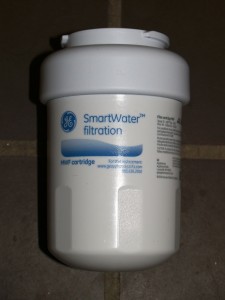
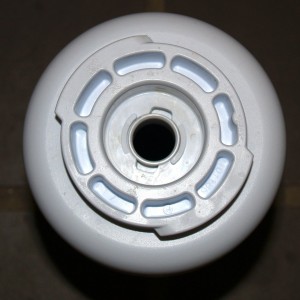
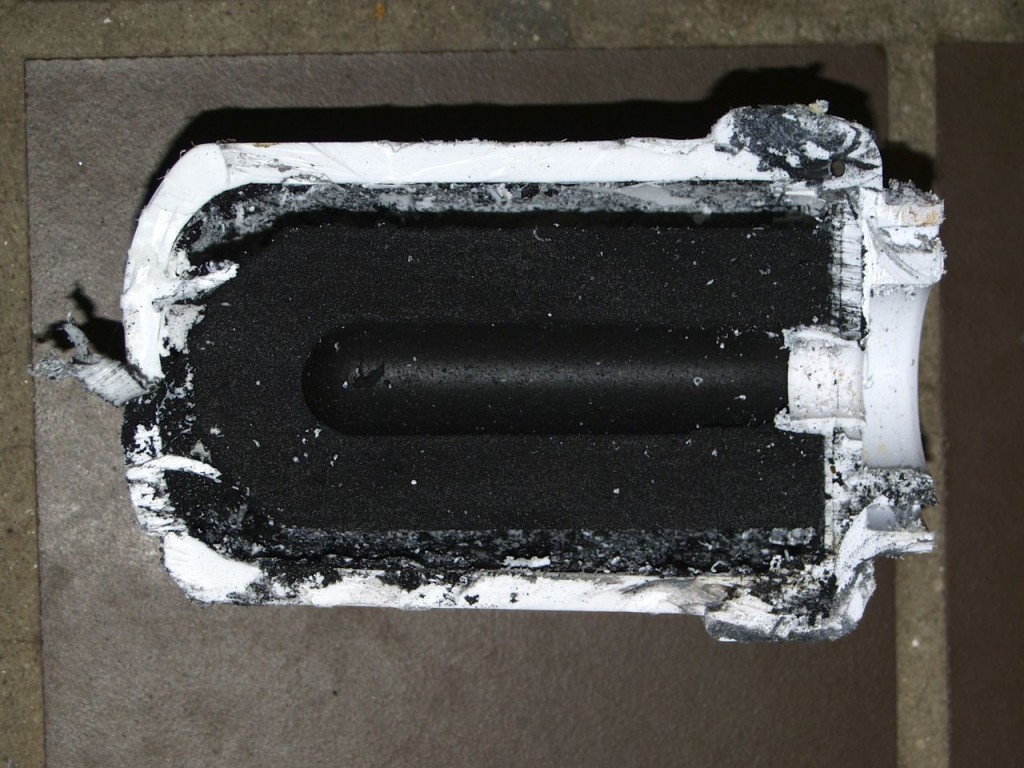
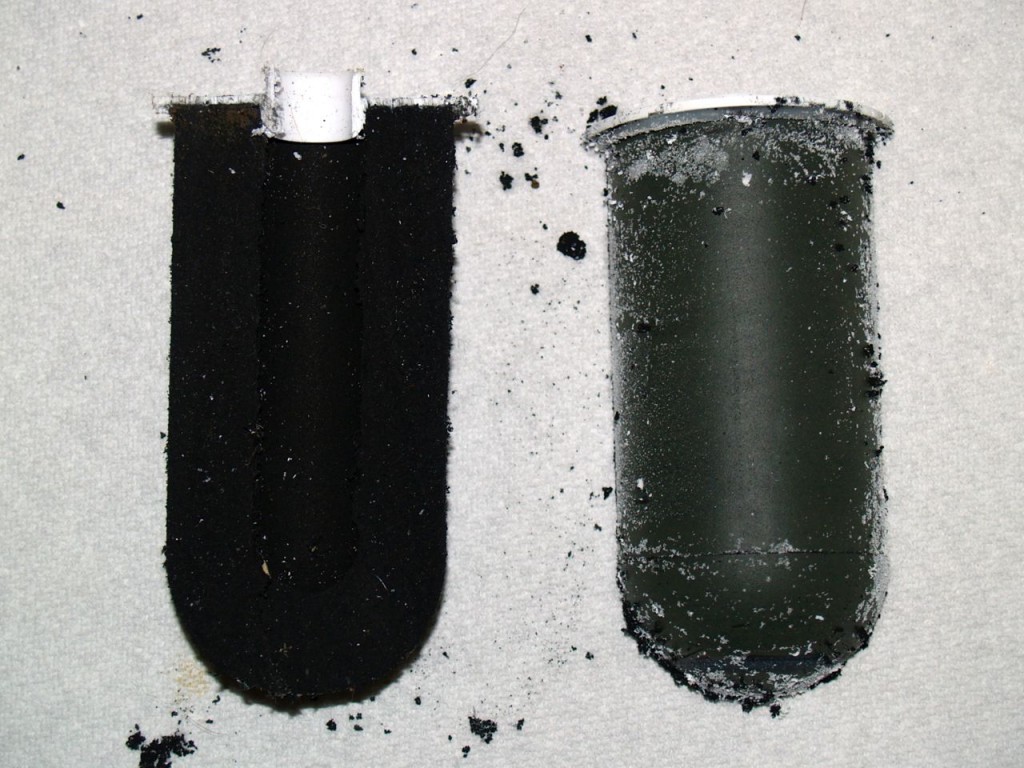
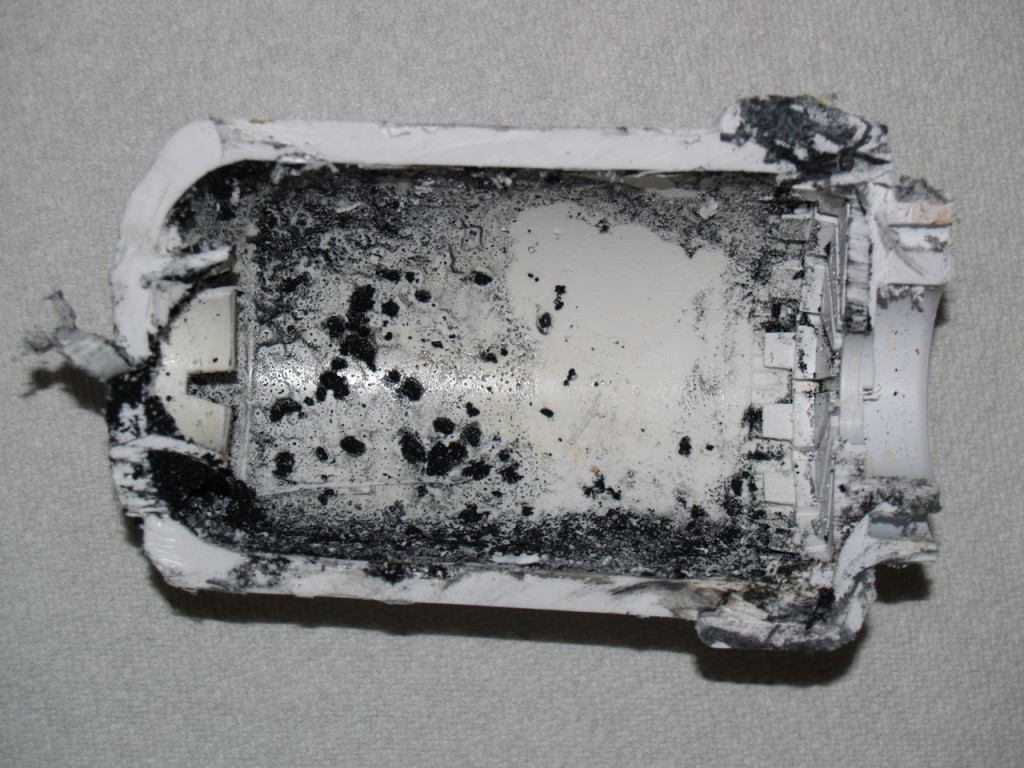
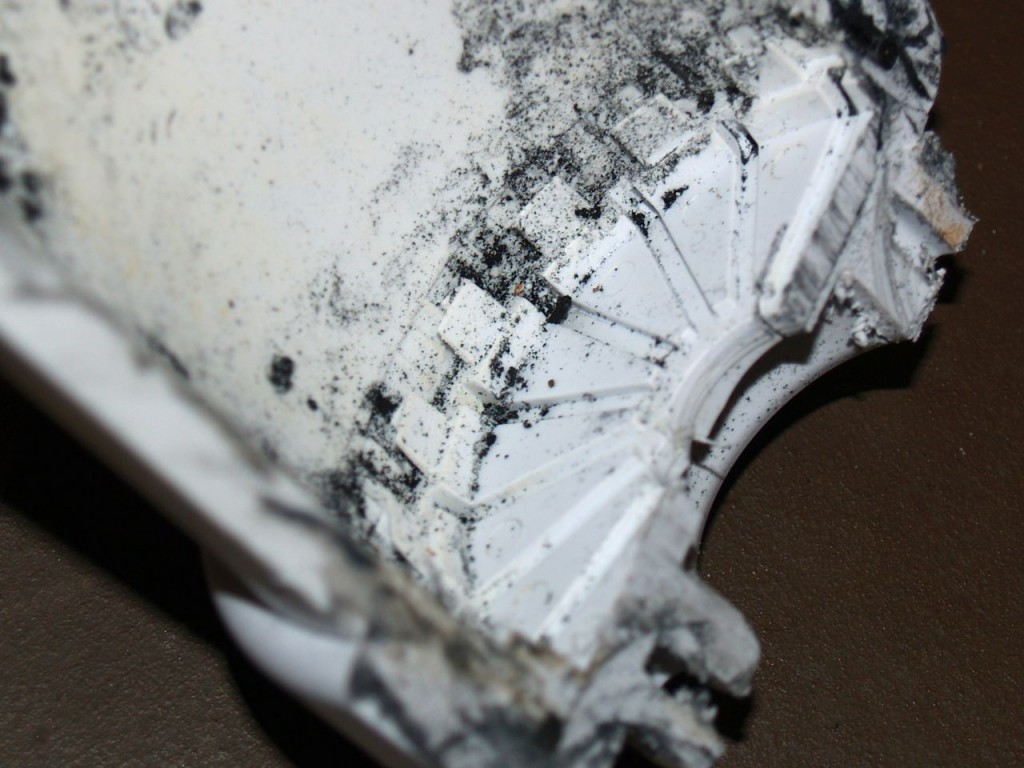
Yes, totally for educational purposes. Not fun at all…
You share my enthusiasm for taking things apart to see how they work…
I agree with your assessment of the radial passages and the two rectangular openings, but consider this about the flow direction –
Most filters of this general shape (and there are many, including auto oil and fuel filters) have fluid flow from the outside in, but most of them have accordion paper elements, and the inward flow makes it easier to reinforce the element against the pressure of the flow. This is a rigid element, so probably no issue with that.
Another issue though – the ‘inlet’ side of the filter would tend to gunk up with use (gray color?) so it would be better to use the larger surface – much larger in this case – as the ‘input’; to spread the gunk over a greater area, so a fixed amount of gunk has less impact on the flow rate.
Good pics, too! Looking forward to more cut-open things.
I did not know that most filters of that shape have flow from the outside inward. I completely agree with you about it making more sense for the inlet side to have the gray color. I think the main thing that is throwing me for the flow direction is the shape of the carbon filter. If it flows inward then would the carbon filter have the structural strength necessary to maintain that shape? Then again, I guess the reverse question is true also. The carbon filter was very strong and extremely dense. I had to saw through it. I would not break in my hand at all. I also am not sure what water pressure through the filter is as, I don’t know if it normal household water pressure, or if the refrigerator steps down the pressure. I feel I need more research into this.
Well according to this random internet source, appliances need to deal with anywhere from 15 to 85 psi, but I think typical is 30-55. http://ths.gardenweb.com/forums/load/plumbing/msg0513272612248.html
I’d guess you’re right that there’s a regulator – given that wide variation – but I’d think it would make sense to put that downstream of the filter, so that it hides the pressure drop in the filter, which would tend to increase as the filter gunks up. Bear in mind that only the outer shell of the filter needs to withstand the full water pressure; the effective pressure load on the element is just the difference between in & out pressures, which quickly becomes 0 when the water stops flowing. And if the flow rate is limited, the pressure diff may not get too high under any circumstances. It would generally be
flow_rate * (clean_fllter_resistance + gunk_load_term).
Car oil filters have a ‘bypass valve’, which is just a disk held down by a spring, so that if the pressure diff gets too high (because you didn’t change the filter and it’s all gunked up, or because the oil is cold and viscous), then the valve opens, thus letting unfiltered oil through. This, of course, is not great, but is much better than the alternatives, which are (a) too-low oil flow or (b) rupturing the filter element and letting all the gunk and bits of filter paper out, Oil pumps are positive displacement, so they will push a specific flow rate of oil regardless of the pressure required to do so — until something breaks.
Trivia: When they change the oil filter in an aircraft engine, it’s cut open, and the paper rolled out flat to check for metal particles, which of course would indicate a problem if there were too many.
Hi,
Very impressive. I haven’t seen the inner of a water filter before. Now I know how it works. Thanks, anyway.
Thanks! I bought a new (Craigslist) refrigerator last night I was totally going to have to get out the sawzall after work today to cut up the old filter and see how one hole could filter water. You saved me the trouble. So, like you said the holes on the side of the collar are the inlet, and using the larger surface area of the outside of the media, the filtered water then flows up through the opening in the middle. Great job with the website and thanks again! Being so curious is a lot of work, but not knowing is worse.
Was going to do it myself thanks for saving me time and ending my curiosity.well done. Keep the curiosity alive
Great explanation of the anatomy and physiology of water filter but I need to know the urology- how does the water get from the top of the filter’s hole or channel system back to the ureter and into my glass-
Thanks
Philskie